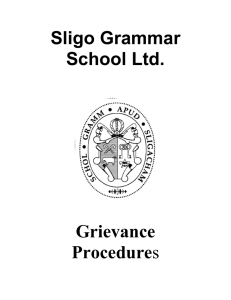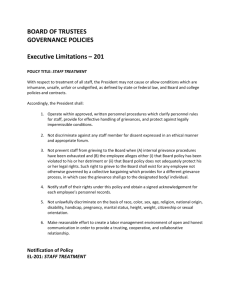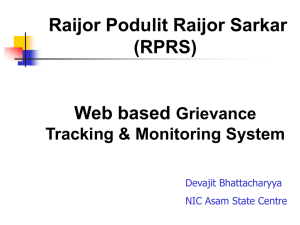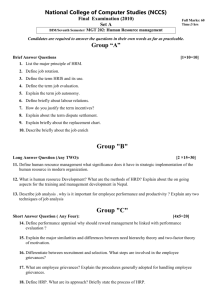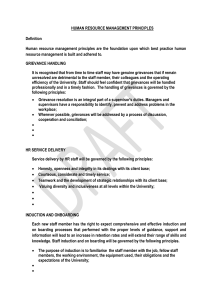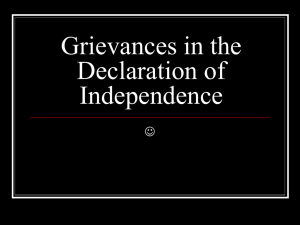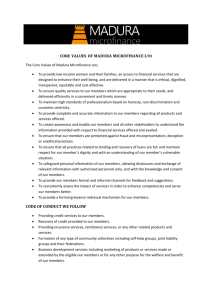Analysis Training
advertisement
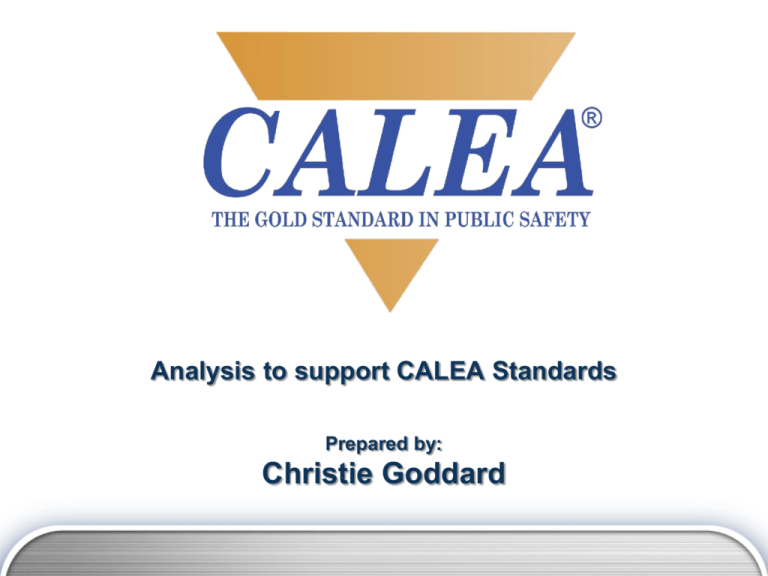
Analysis to support CALEA Standards Prepared by: Christie Goddard Purpose of Analysis • Analysis is a validation of performance and professionalism • Tool for agency resource allocation Definition of Analysis Analysis is a systematic, structured process for dissecting an event into its basic parts to identify important essential elements. Analysis should reveal patterns or trends that could be predictive or could indicate program effectiveness, training needs, equipment upgrade needs and/or policy modification needs. Analysis is continual. It never stops. Collect Event/Element Document and report findings Data Identify cause and/or effect of Patterns/ Trends Collate Identify Event/Element Patterns/ Trends Data Analysis is continual. It never stops. Collect Event/Element Data Collect Event/Element Data • In order to analyze data, you must first collect it. • List what the data is (i.e., Calls for Service based on location, time of day, type of response, photographs, etc.) • Where did you get the data? (i.e., CAD system, U.C.R., Citizen Survey, etc.) • The time period in which the data is collected, (i.e., January 1, 2012 to December 31, 2012, 0800 hours through 1600 hours, etc.). Analysis is continual. It never stops. Collect Event/Element Data Collate Event/Element Data Collate Event/Element Data Put the data in some type of order so that it can be reviewed. Location By Pass 48 & Main Broadway and Main Broadway and Miller Rd Columbus and By-Pass 48 Columbus and Monroe Broadway and Silver Cook and By Pass 48 By Pass 48 and Monroe Rd Miller Rd and Drake Warren and Broadway Silver and West Cincinnati and West 2002 10 10 9 7 7 7 7 6 6 5 5 5 2001 Change 5 50.00% 1 90.00% 5 44.44% 1 85.71% 9 -28.57% 4 42.86% 10 -42.86% 1 83.33% 1 83.33% 3 40.00% 1 80.00% 1 80.00% Street crime allegations by day of w eek 18. 0% 16. 0% 14. 0% 12. 0% This is a Visual Representation of Data 10. 0% 8. 0% 6. 0% 4. 0% 2. 0% 0. 0% M onday T uesday Wednesday T hur sday D a y of we e k Fr i day Sat ur day Sunday THIS IS NOT AN ANALYSIS !!! Collate Event/Element Data Grievances Analysis for 2012: Grievance Type Grievance Total Work Schedule 2 Supervisor 1 Discipline 4 Analysis is continual. It never stops. Collect Event/Element Data Collate Identify Event/Element Patterns/ Trends Data Identify Patterns/ Trends • Handing someone raw data does not tell them anything. • Data is open to interpretation. • Identify the W’s - Who, What, When, Where, Why Where does the patter/trend occur? When does the patter/trend occur? Who is working when the patter/trend is occurring? - Is this an isolated problem? Analysis is continual. It never stops. Collect Event/Element Data Identify cause and/or effect of Patterns/ Trends Collate Identify Event/Element Patterns/ Trends Data Identify cause and/or effect of Patterns/ Trends • What harm results from the pattern/trend? • Who is directly affected by the pattern/trend? • Potential Areas to Review: - program effectiveness, training, equipment, and policies Analysis is continual. It never stops. Collect Event/Element Document and report findings Data Identify cause and/or effect of Patterns/ Trends Collate Identify Event/Element Patterns/ Trends Data Document and report findings Grievances Analysis for 2012: Grievance Type Grievance Total Work Schedule 2 Supervisor 1 Discipline 4 The results of the Grievances Analysis for 2012 revealed a total of seven grievances. Two grievances related to work schedules, one was specific to a supervisor and the remaining four were related to discipline. Document and Report Findings Upon reviewing the grievance relating to the two work schedule grievances were filed from patrol officers who had been reassigned to different shifts and supervisors and were not happy with their assignments. Based upon department policy, patrol officers are required to rotate their shift and supervisor assignments every four months, unless otherwise instructed by the Chief of Police. The two patrol officers in question were retrained on departmental policies relating to working hours and assignments and no further action was required. Document and Report Findings The grievance filed against the supervisor was submitted by one of her subordinates. The subordinate claimed the supervisor was improperly singling her out for mistreatment and discipline. The grievance was thoroughly investigated by the internal affairs division and determined to be a personality conflict between supervisor and subordinate. Both employees were counseled on the department’s policies relating to conflict resolution. The four grievances filed regarding discipline were also thoroughly investigated and determined to be founded. All employees were disciplined appropriately for his or her offense as outlined in the department’s policies. Document and Report Findings Recommendations/Conclusions: Upon reviewing all grievances submitted for 2012, for patterns or trends that could be predictive or could indicate program effectiveness, training needs, equipment upgrade needs and/or policy modification needs, it has been determined that some retraining of employee related to departmental policies was needed. All employees have been appropriately retrained and no further action was required. What do we do when there are not enough events/elements to conduct an analysis? Even if no data..analysis must be done -Analyze polices and procedures Common Errors Just reporting raw data, no Narrative Location By Pass 48 & Main Broadway and Main Broadway and Miller Rd Columbus and By-Pass 48 Columbus and Monroe Broadway and Silver Cook and By Pass 48 By Pass 48 and Monroe Rd Miller Rd and Drake Warren and Broadway Silver and West Cincinnati and West 2002 10 10 9 7 7 7 7 6 6 5 5 5 2001 Change 5 50.00% 1 90.00% 5 44.44% 1 85.71% 9 -28.57% 4 42.86% 10 -42.86% 1 83.33% 1 83.33% 3 40.00% 1 80.00% 1 80.00% Street crime allegations by day of w eek 18. 0% 16. 0% 14. 0% 12. 0% 10. 0% 8. 0% 6. 0% 4. 0% 2. 0% 0. 0% M onday T uesday Wednesday T hur sday D a y of we e k Fr i day Sat ur day Sunday Common Errors Basic one or two sentence summary, only restating what data is reporting Grievances Analysis for 2012: Grievance Type Grievance Total 2012 Promotion 0 Work Schedule 0 Supervisor 0 Discipline 1 The results of the Grievances Analysis for 2012 revealed a total of one grievance. Requests Similar to Analysis REVIEWTo examine or study, Less formal than an Analysis Example: Review of Performance Evaluation ….each performance evaluation report is reviewed and signed by the rater's supervisor (Standard numbers 35.1.5c LE, 3.4.5 PSCAP, 4.4.5 PSTAP) Requests Similar to Analysis EVALUATIONA careful appraisal and study to determine the significance and/or worth or condition, and to draw conclusions pertaining to an item, project, or undertaking. Example: Rater Evaluation ….A written directive requires raters to be evaluated by their supervisors regarding the quality of ratings given employees. (Standard numbers 35.1.8 LE, 3.4.11 PSCAP, 4.4.9 PSTAP) Requests Similar to Analysis TASK ANALYSISA systematic, structured process for dissecting a job into its basic parts. A task analysis identifies the important or essential elements of a job, the key work behaviors, and the knowledge, skills, and abilities required for these work behaviors. Can use same structure as analysis to get results/proof of compliance Example: ….. . A written task analysis of every class of every employee ….. (Standard numbers 21.1.1 LE, 3.1.1 PSCAP, 4.1.1 PSTAP) TASK ANALYSIS: VALDOSTA POLICE DEPARTMENT Document/Report Collate Data Collect Data Requests Similar to Analysis ADMINISTRATIVE REVIEWA DOCUMENTED review of an incident or occurrence prepared by or for the CEO or his/her designee. The review should indicate whether policy, training, equipment, or disciplinary issues should be addressed. Standards Requiring Analysis MAJOR STANDARDS REQUIRING ANALYSIS BY PROGRAM. REVIEW EACH PROGRAM TO ENSURE YOU HAVE MET ALL STANDARDS REQUIRING ANALYSIS Standards Requiring Analysis Law Enforcement Accreditation Program 1.3.13 Use of Force Analysis Annually, the agency conducts an analysis of its use of force activities, policies and practices. Standards Requiring Analysis Law Enforcement Accreditation Program 25.1.3 Grievance Analysis Annually, the agency conducts an analysis of its grievances, as well as supporting policies and practices. Standards Requiring Analysis Law Enforcement Accreditation Program 41.2.2 Pursuit Analysis A written directive governs pursuit of motor vehicles, to include: j. conducting a documented annual analysis of pursuit reports; and k. conducting a documented annual review of pursuit policies and reporting procedures. Standards Requiring Analysis Public Safety Communications Accreditation Program 2.2.5 Agency Liability, Report Analysis The agency conducts an annual documented analysis of those reports required by standard 2.2.3, as well as the process for collecting and utilizing data from the respective reports. Standards Requiring Analysis Public Safety Communications Accreditation Program 3.5.3 Annual Analysis of Grievances A written directive requires a documented annual analysis of grievances which includes a review of the policies, practices and procedures utilized to support the grievance process. Standards Requiring Analysis Public Safety Training Academy Accreditation Program 4.5.3 Analysis of Grievances A written directive requires an annual analysis of grievances which includes a review of the policies, practices and procedures utilized to support the grievance process. Standards Requiring Analysis Public Safety Campus Security Accreditation Program 2.1.13 Annual Analysis of Use of Force Reports The agency conducts a documented annual analysis of those reports required by standard 2.1.6, as well as the process for collecting and utilizing data from the respective reports. Standards Requiring Analysis Public Safety Campus Security Accreditation Program 14.1.3 Analysis of Grievances The campus security agency compiles a documented annual analysis of grievances which includes a review of the policies, practices and procedures utilized to support the grievance process. Analysis All programs Timeframe for Analysis •Data completed within 12 months (Annual)same 12 months each year •Analysis needs to be completed within 6 months of data collection •Even if no data..analysis must be done Analysis Commission Expectations •A DOCUMENTED analysis that reviews the data and the policies and procedures that offers recommendations and conclusions based upon the information reviewed. • Completed within the required timeframe of the standard. •An actual analysis each year.. Do not simply copy and change dates. Analysis Resources • CALEA REGIONAL PROGRAM MANAGER • International Association of Crime Analysts • International Assn. of Law Enforcement Intelligence Analysts • Justice Research and Statistics Association Questions
